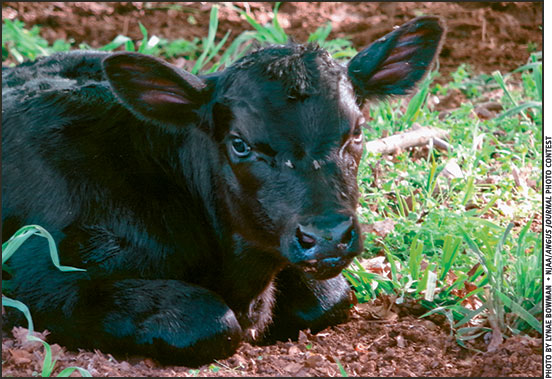
Black calves in a pasture with no shade and no breeze may not be able to handle it.
Shade for Hot-weather Calving
Newborns and young calves are more susceptible to weather stress than older animals. In cold or wet weather, calving cows and newborns need shelter from wet storms and wind. In hot weather, they need shade. Fall calving can be smooth sailing in good weather, or miserable if temperatures are still high.
A young calf has an immature “thermostat” and has trouble regulating body temperature during weather extremes — chilling more readily in cold weather or becoming hotter during hot weather than an older calf. The young calf also doesn’t have the body mass and reserves of a larger animal and is susceptible to dehydration. When it’s hot, the calf becomes lethargic and doesn’t feel like nursing. It isn’t drinking water yet, and won’t nurse enough to keep from being dehydrated. The problem is compounded if it gets sick, losing fluid through diarrhea.
In hot weather, provide shade. Heat stress can take a severe toll on young calves, and their color makes a difference. Black calves in a pasture with no shade and no breeze may not be able to handle it.
Shade is important in an environment without much cloud cover. Animals that are constantly exposed to sun get much hotter than those with access to shade. If you don’t have natural shade (brush and trees), you can create shade with a series of shed roofs. You need a high roof, at least 10 feet (ft.) off the ground — 15 ft. or higher is better — to allow plenty of air flow underneath to enable a breeze to help cool the animals.
Natural air movement under the roof is affected by height and size of the roof, slope, and the ease with which air can move through it (no walls). Shade cloth has an advantage over a solid roof; air can pass through the material. A sloping roof creates better ventilation than a flat one.
Solar radiation (heat from the sun) causes the air directly under the roof to become hotter than the surrounding air and it rises. This creates air movement under the roof by allowing the hot air to slide upward on the inside of a sloping roof. As this hotter air moves upward, the movement drags air in from the sides to replace it. The rate of upward movement depends on the slope of the roof and roughness of the material. A slope of 18° works adequately on a small structure, and a 10°-15° slope will have a similar effect in larger structures.
It pays to insulate a solid roof, especially if it’s metal. Otherwise it may produce more radiant heat and be like an oven underneath. A light-colored roof reflects more sunlight and stays cooler underneath.
If weather is extremely hot, a barn stall with fans can help keep a calving cow or newborn calves from overheating. In a pen, you may have to figure out a way to cool cattle during a heat wave, like putting up shade or using sprinklers to spray them with a mist of water. For baby calves, heat stress can be just as deadly as cold stress.
Editor’s Note: Heather Smith Thomas speaks from experience as a cattlewoman and freelancer from Salmon, Idaho.






